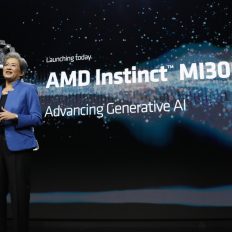AMD is merging its consumer "RDNA" and Data Center "CDNA" GPUs under one unified architecture with the announcement of UDNA.
AMD Plans To Bring Some Serious Competition In Next-Gen Markets, Merges RDNA & CDNA Families Into UDNA Architecture For The Future
Team Red is transitioning its business model to something much more massive, likely targeting a larger market share. AMD has looked determined towards its upcoming RDNA 4 lineup, as this is not just based on the firm's statements; previous leaks have indicated that the firm has "sharpened the blade" and is ready to hit the mainstream markets more aggressively than ever. In a statement by AMD's Jack Huynh, it is now revealed that the firm plans to merge its consumer GPUs and data center architectures to increase market relevance.

The "unified" approach isn't entirely new for AMD, given that the firm had its product portfolio revolving around the GCN architecture until 2019, after which the RDNA & the CDNA architectures came into existence. This was an attempt to navigate its way through the newly emerged markets, and having separate lineups meant the development was consistent across both platforms. Still, in modern times, the actual race lies in being the very best, and with having a single architecture, AMD plans to increase development massively.
So, the new architecture will now be called "UDNA," which is said to reshape AMD's business structure. Interestingly, NVIDIA employs a similar approach with its modern-day consumer and AI GPUs, such as the "Blackwell" architecture, where the AI lineup and the rumored GeForce RTX 50 series GPUs are named under a single label.
So, part of a big change at AMD is today we have a CDNA architecture for our Instinct data center GPUs and RDNA for the consumer stuff. It’s forked. Going forward, we will call it UDNA. There'll be one unified architecture, both Instinct and client [consumer]. We'll unify it so that it will be so much easier for developers versus today, where they have to choose and value is not improving.
So, going forward, we’re thinking about not just RDNA 5, RDNA 6, RDNA 7, but UDNA 6 and UDNA 7. We plan the next three generations because once we get the optimizations, I don't want to have to change the memory hierarchy, and then we lose a lot of optimizations. So, we're kind of forcing that issue about full forward and backward compatibility. We do that on Xbox today; it’s very doable but requires advanced planning. It’s a lot more work to do, but that’s the direction we’re going.
- AMD's Jack Hunyh via Tom's Hardware
Team Red says that UDNA's naming scheme will sound something like "UDNA 6 and UDNA 7", and the firm is working on backward compatibility with existing RDNA and CDNA architectures as well. One important factor of having a unified architecture is how accessible the UDNA platform will be to developers, and in the longer term, Huynh believes that they plan to compete with NVIDIA's CUDA, eventually leveling its open-source ROCm software stack, but this is uncertain for now, given that the firm has a lot of stuff to catch up on, both on hardware and software levels.

Just recently, AMD also announced that they are looking at focusing on GPU scalability, which means that the firm is eager to target a wider segment of the markets rather than being involved in the race for flagship GPU models. So, while the firm does look to be heading in the right direction, we can't conclude how these decisions pan out for AMD, given that the markets are often uncertain and full of surprises.







